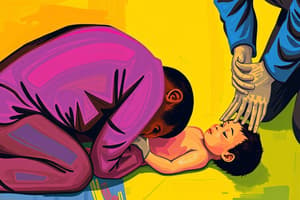Podcast
Questions and Answers
When performing CPR on an infant (laying face-up), you should use:
When performing CPR on an infant (laying face-up), you should use:
- One hand
- Two fingers (correct)
- No hands
- Both hands
For Adults/Adolescents, you should call/activate EMS before CPR.
For Adults/Adolescents, you should call/activate EMS before CPR.
True (A)
If you witness a child collapse, you should:
If you witness a child collapse, you should:
Activate EMS
You can check tasks (breathing and pulse) simultaneously within 10 seconds.
You can check tasks (breathing and pulse) simultaneously within 10 seconds.
When a patient is unconscious and non-responsive, CPR should be performed.
When a patient is unconscious and non-responsive, CPR should be performed.
What is the correct word for C in C.A.B.?
What is the correct word for C in C.A.B.?
If the patient's chest is not inflating during the breathing task, you should check the patient's:
If the patient's chest is not inflating during the breathing task, you should check the patient's:
100-120 chest compressions should be performed on the patient per minute.
100-120 chest compressions should be performed on the patient per minute.
During the breathing task for infants, you should:
During the breathing task for infants, you should:
You should ask the patient if He/She is okay before performing CPR.
You should ask the patient if He/She is okay before performing CPR.
Flashcards are hidden until you start studying
Study Notes
CPR Techniques and Guidelines
- Use 2 fingers to perform CPR on an infant while they are laying face-up.
- For adults and adolescents, call/activate EMS before initiating CPR.
- If a child collapses unexpectedly, the first step is to activate EMS immediately.
Key Assessment Protocols
- Breathing and pulse checks can be performed simultaneously within 10 seconds to assess responsiveness.
- It is deemed necessary to perform CPR on patients who are unconscious and non-responsive.
CPR Acronym and Actions
- The C in C.A.B. stands for Circulation, a crucial aspect of CPR.
- If the patient's chest does not inflate during rescue breathing, it is important to check their airway for obstructions.
Compressions and Breathing Techniques
- Execute 100-120 chest compressions per minute during CPR to maintain blood flow.
- For infants, during the breathing task, ensure to cover both their mouth and nose while performing rescue breathing.
Patient Interaction
- It's important to ask the patient if they are okay before commencing CPR to determine responsiveness.
Studying That Suits You
Use AI to generate personalized quizzes and flashcards to suit your learning preferences.




